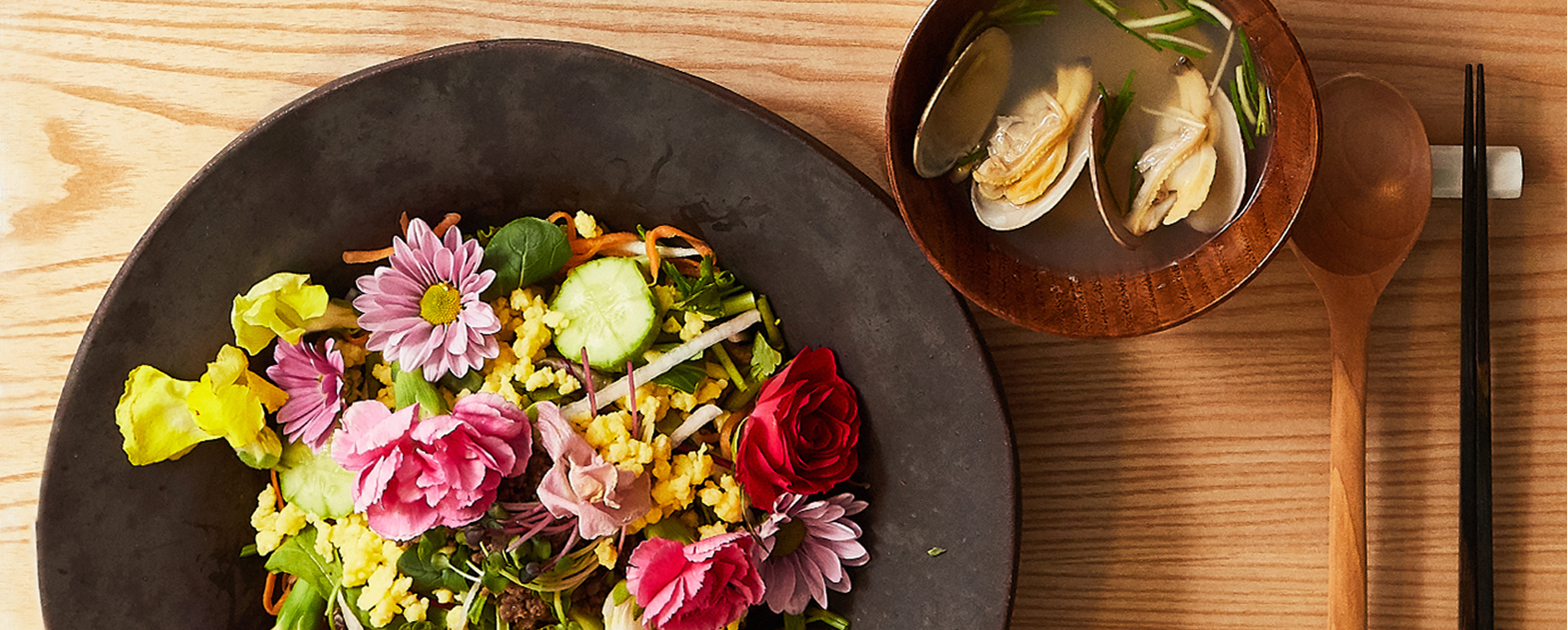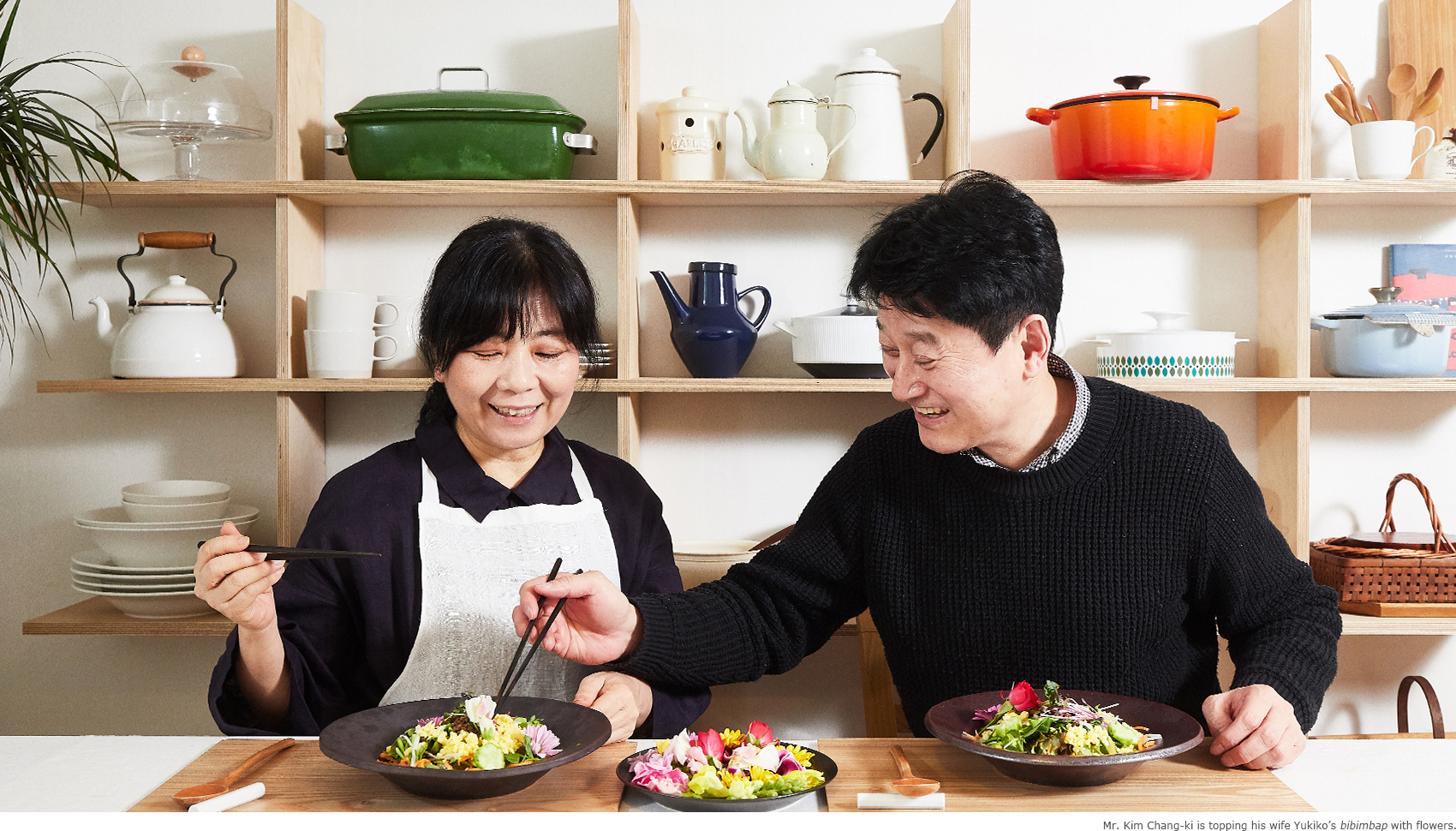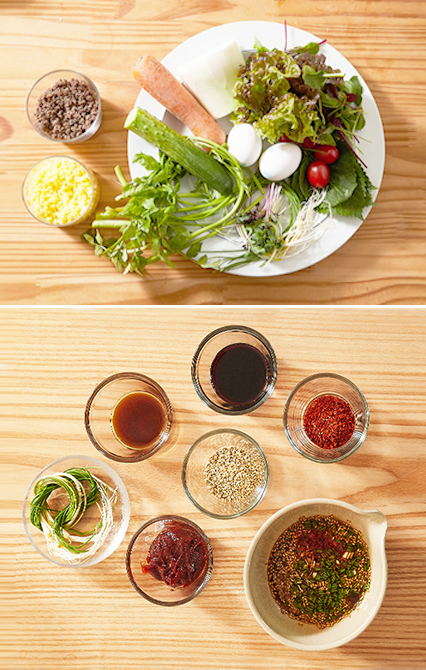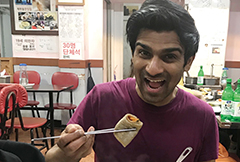

Flower Bibimbap Mixed Rice,
A Spring Garden on the Table
A Hearty Meal of Spring Greens
Bibimbap mixed rice is a Korean dish that has long been popular among non-Koreans. For some time now, the dish has been served to airline passengers as an in-flight meal. Why is it that we still rave over Bibimbap mixed rice? This all-time favorite dish was introduced to non-Koreans in a famous TV show called “Yoon’s Kitchen.” Simply by adding colorful flowers as an extra topping, you get "flower Bibimbap mixed rice." Indeed, spring has arrived at the dining table.
Written by Park Ji-yeon Photographed by Studio Kenn

Eating Habits Revealed
Bibimbap mixed rice, which is a bowl of white rice topped with seasoned greens and stir-fried beef, is a representative Korean dish. The earliest records of it can be found in a recipe book called the Shi-eui-jeon-seo written around the 1800s. According to the book’s traditional recipe, bibimbap mixed rice is made by mixing various ingredients together, such as stir-fried beef, slices of savory pancakes, assorted greens, white rice and ground sesame. While this might not seem like a long history, it’s steeped in cultural significance.
The ingredients used to make bibimbap mixed rice vary across region. In one part of Korea, bibimbap mixed rice is made with 30 different ingredients. The dish becomes more unique and flavorful when topped with local specialties. Depending on where you are, gochujang red pepper paste is sometimes replaced with a different paste. A common characteristic of these endless varieties is that the ingredients are all mixed together. Hence, the generic name “bibimbap” is broadly applied to any dish that is enjoyed by mixing all the ingredients together in a bowl.

Dallaejang, Yukiko’s Secret
Ingredient for Bibimbap
The chef behind the beautiful flower bibimbap mixed rice featured in this issue is Yukiko, a Japanese veteran chef who has been living in Korea for 30 years. She has taught cooking classes about Japanese homemade food for the past two decades.
When asked about her favorite Korean dish, Yukiko excitedly answers, “Samgyeopsal grilled pork belly!” with an expression of sheer contentment. Her second favorite Korean dish is namul seasoned vegetables. She introduces a healthy dish called flower bibimbap mixed rice. It’s made by adding edible flowers and assorted greens that are in-season. Her secret ingredient is dallaejang. It’s used as a substitute for the standard gochujang red pepper paste. Dallae, known for its unique taste and scent, is a signature spring green that can only be found in the wild in March or April. It can be put into stews or made into a marinade or dressing to yield its palatable bitterness.
Dallaejang is a soy sauce dressing that’s relatively easy to make. However, the dallae itself can be difficult to prepare. The bulb-like white ends of the dallae roots should be carefully washed, and the yellowish skin needs to be peeled off. Next, the washed roots are chopped and added to the soy sauce base. The unique aroma of dallaejang is bound to stimulate your appetite.

The Philosophy of Mixing
Yukiko’s husband, Kim Chang-ki, enters the kitchen to help out with the cooking. While bibimbap mixed rice looks simple to make, because of the number of ingredients that need to be prepared beforehand, it’s always better to have more helping hands. More than anything, the beef has to be cooked in a specific way to acquire the best taste. Beef that’s marinated in cooking wine must be spread on a pan before the stove is turned on. You should only start to flip the beef strips after the top part of the slices has turned white.
When Chang-ki fails to get the timing right, Yukiko says, “If you flip now, the beef will become watery!” He soon forgets his wife’s advice and starts stir-frying again, which makes Yukiko burst out laughing. “He’s no expert, but I love that he offers to help,” says Yukiko affectionately. She recalls her husband’s enthusiasm for doing the dishes 30 years ago. Back then, Chang-ki said, “If I did the dishes, we had more time to spend together, perhaps over a cup of coffee.” Moved by his words, she eventually came to Korea to be by his side.
In a bowl of bibimbap mixed rice, many different ingredients are mixed together to bring out the very best taste. This is similar to the loving relationship between Yukiko and her husband. With so much love and effort poured into the dish, they presented a hearty meal warmer than the sunshine of spring.

Flower Garden in a Bowl
The usual way to arrange different ingredients on a bed of rice is to have each ingredient laid next to each other. Yukiko achieved a beautiful visual harmony with her unique arrangement. When making flower bibimbap mixed rice, a bunch of edible flowers is added as a finishing touch. Edible flowers are non-poisonous and are rich in antioxidants, minerals and vitamins. The level of antioxidants in these edible flowers is about 10 times more than that of other fruits and vegetables. Do grab some of these at a nearby supermarket to make your meal healthier and more colorful.
Yukiko and Chang-ki place some flowers in each other’s bowls to complete their masterpiece. They cannot help but exclaim, “Gosh, it’s a flower garden!” The happy couple look at each other and once again burst into laughter.
The dish is beautiful to look at, but how does it taste? Yukiko replies, “It’s my first time adding flowers to bibimbap mixed rice, and it’s simply delicious. I love the rich scent of chrysanthemums!” Chang-ki says, “It’s a spoonful of spring, from the fragrant dallaejang and the flowers to the spring greens.”
The basic ingredients of flower bibimbap mixed rice are cooked, while the flowers are tossed on top as they are, creating a harmonious blend of cooked and fresh ingredients. Amid this harmony, each ingredient retains its unique flavor and form. Bibimbap mixed rice is a melting pot of different elements, and the same can be said about the lovely couple, who are from two different countries but are now one in marriage. In this sense, a mutual love for food can serve as an ingredient for peace and harmony in our globalized world.


Cook Tip
-
Ingredients (serves 2)
Flower bibimbap
Handful of edible flowers, 1 carrot, 1 cucumber, 1 medium leek, 5 sesame leaves, 5 lettuce leaves, etc. (Other vegetable options: Radish, microgreens, cherry tomatoes, etc.)
Dallaejang dressing
One bunch of dallae, 2T stock made with dried anchovies, dried kelp, dried shrimp, and dried shiitake mushrooms, 3T soy sauce, ½T red-pepper powder, 2T sesame oil, 1T sesame seeds
Stir-fried beef
200g minced beef, 3T cooking wine, 1½ T sugar, 2T soy sauce
Fried egg
3 eggs, 2½T sugar, 2t cooking wine, t salt

Other Articles




Jejudo Island

Carpenter and Important Intangible Cultural Property No. 55

A Universe of Their Own

Signpost to Lasting Peace


without the Beef, Please

the Pulse on the Young
Application of subscription
Sign upReaders’ Comments
GoThe event winners
Go


 April 2018
April 2018


